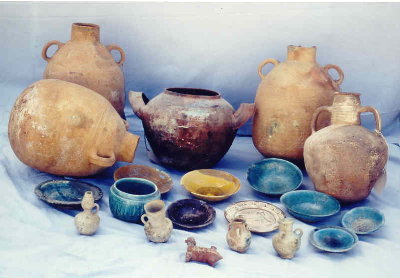Curators: Avner Raban, Ya'el D. Arnon, Rachel Pollak
Exhibition Opening: June 1999
 Jars from the exhibitionThis exhibition displays finds from excavations that have been conducted in Caesarea since 1992 as part of the tourist development of the site. The range of items in the collection demonstrates the character of the material culture that existed in Caesarea in the early 11th century as well as its affinity to Fatimid Egypt and its capital, Fustat. Pottery, glass utensils, metal items, objects of wood and ivory, candles, jewels, and more are displayed in this exhibition.
Jars from the exhibitionThis exhibition displays finds from excavations that have been conducted in Caesarea since 1992 as part of the tourist development of the site. The range of items in the collection demonstrates the character of the material culture that existed in Caesarea in the early 11th century as well as its affinity to Fatimid Egypt and its capital, Fustat. Pottery, glass utensils, metal items, objects of wood and ivory, candles, jewels, and more are displayed in this exhibition.
Caesarea was founded by King Herod 10 BCE in the northwest corner of his kingdom. It developed over the course of generations and eventually became the largest urban center in Eretz Israel. The urban settlement, which became a Roman provincial capital, was conquered for the first time in its history in 640 CE by the commander of the armies of the first Caliph, Amr ibn al-Khattab. For the next 470 years, Caesarea continued to exist as a real city, but was noticeably affected by the changes in regime from one Muslim dynasty to another and then by the Byzantine Empire (in the 780s and in 975).
The Hecht Museum has twice in the past mounted exhibitions devoted to archeological finds from Caesarea: "Mound and Sea" in 1986 and "Caesarea - A Commercial City by the Sea" in 1995. Those exhibitions concentrated mainly on a study of the city's ancient ports, including the sea bottom and coast, and on testimonies of the far stretching land and sea trade that was focused at Caesarea during the Roman Byzantine era. In this exhibition, finds are displayed that describe the richness of Caesarea in the ancient Islamic period. All three exhibitions are expressions of the ties that exist between the Hecht Museum and archeological activity at the University of Haifa.

